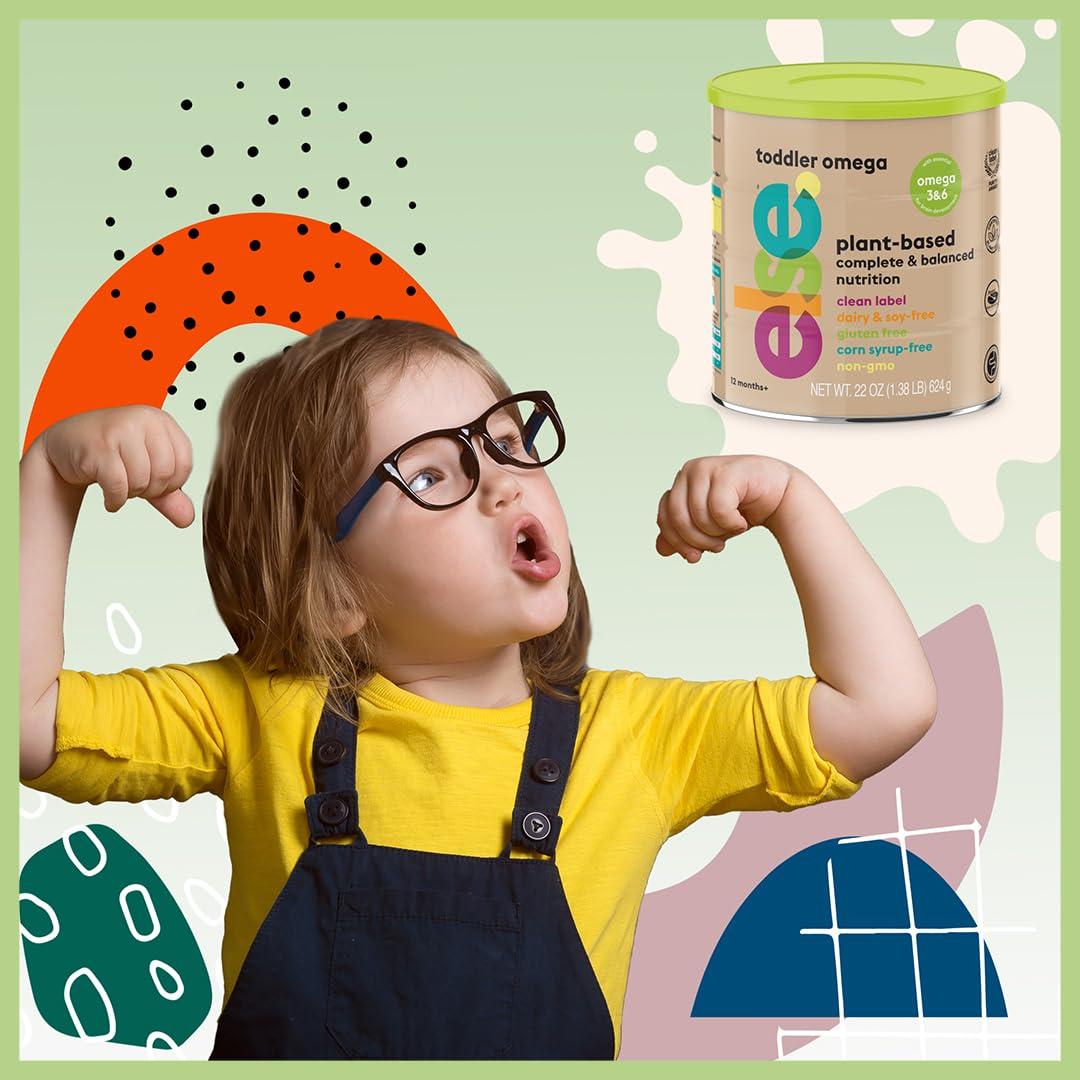6 Essential Nutrients for Kids
Ensuring that kids receive essential nutrients is crucial for their growth and development. Learn about the 6 key nutrients that children need for optimal health and well-being.
Updated May 30, 2024

A balanced diet is essential for the healthy growth of every child. As children grow up, their vital organs expand, and their brains develop, but in order for this process to take place in the best possible way, children need to have a diet that provides them with all the essential nutrients.
Any undernutrition at this point in life can affect growth and, therefore, be particularly damaging to children. This is why parents need to be very careful about integrating all the essential nutrients their kids need when preparing meal plans and developing healthy eating habits and routines. We put together a list of the six essential nutrients for kids that you should make sure they're getting on a daily basis.
» Discover delicious plant-based formulas packed with essential nutrients for thriving kids
1. Protein
Protein is an essential nutrient and the fundamental constituent of all living tissues, including muscles and organs. It helps a child's body build cells, fight infection, break down food into energy, and carry oxygen. Protein is also essential for the growth and repair of tissues in children and adults, but children shouldn't miss it even for a day because the growth process could be affected.
» Understand the protein needs of infants and toddlers to ensure healthy growth
The primary sources of protein include:
- Meat
- Eggs
- Fish
- Dairy products, including cheese and yogurt
- Beans, legumes
- Tofu and soy products
For babies younger than six months, breastmilk or formula should be the exclusive source of protein. Older children can get their protein intake from a mix of animal and plant-based protein. The daily amount of protein recommended is based on the child's weight, but it should typically be, on average, 1 g of protein per kilogram of body weight. Ideally, a child should eat various proteins from both plant and animal sources.
» Check out the best nutritious kids' shakes for balanced growth
Protein may be a particular nutrient of interest for children who follow a vegan or vegetarian diet. If you are simply vegetarian, dairy, eggs, or cheese can be good sources. Vegan diets are more challenging to balance in terms of protein, so parents should carefully watch their children's protein intake. A well-balanced vegan diet will ensure that your child doesn’t suffer from many deficiencies or problems with growth.
» Give your kids a boost of plant-powered nutrition
Quality of Animal and Vegetable Proteins
The quality of protein varies depending on the food. Proteins of animal origin contain all nine essential amino acids and are therefore considered "complete." Only a few vegetable proteins (soy, quinoa, buckwheat) fall into the same category and are of excellent quality. Other vegetable proteins must be combined with complementary foods to provide all nine essential amino acids. These combinations don't necessarily need to be made during the same meal.
Here are examples of associations that make plant proteins complete:
- Legumes + grain products (e.g., black beans + rice)
- Legumes + nuts or seeds (e.g., hummus made from chickpeas + almond butter)
» Nourish your little ones with delicious, plant-protein nutritional shakes
2. Carbohydrates
Carbohydrates are found in many of the foods we eat, providing about 60% of the energy we need. Some foods that contain carbohydrates include:
- Bread
- Cereals
- Starchy foods (potatoes, rice, pasta, semolina)
- Certain tuberous vegetables (carrots, beets)
- Pulses (peas, beans, lentils)
Carbohydrates are also in foods containing refined sugar, but these are much less nutritious than those in non-processed foods and provide few essential vitamins and minerals.
Infants and children need more carbohydrates than adults. The recommended percentage of carbs in a child's diet is 50 to 55% of the total daily energy intake. When choosing carbs for your child’s diet, it's essential to focus on complex carbohydrates to provide the necessary energy for the day and a hefty dose of fiber. Highly refined or sweetened carb choices should not represent more than 10% of the total daily energy intake.
» Understand why carbs matter and how much carbohydrates babies and toddlers need
3. Fats
Fats provide twice the amount of energy than carbohydrates and proteins. They also promote the absorption of certain vitamins.
» Understand the essential dietary fats for infants and toddlers for optimal health and nutrition
The main sources of fats are:
- Vegetable oils and fats
- Nuts
- Butter
- Cream
- Olives
- Eggs
- Cheese
» Check out the best ways to include more healthy fats in your kiddo's diet
Many children consume more fat than they need. Fat needs vary from person to person, but they should never exceed 30% of the daily calories. Reducing fat intake is possible by consuming fewer processed foods, lower-fat dairy products, and lean meat foods.
Even though an excess of fat should be avoided, it's essential to include certain kinds of fats, such as essential fatty acids, in children's diets since they play an important role in brain growth and development. Essential fatty acids are found in vegetable oils, fish, and nuts.
» Explore the differences between omega-3, 6, and 9 fatty acids
4. Calcium
Calcium represents 2% of our body weight. Although it's concentrated mainly in the bones and teeth, calcium plays an essential role in the functioning of all of our cells. Calcium is involved in multiple functions that are essential to the body, ranging from blood coagulation and muscle contraction to regulating hormone activity.
» Uncover the role of calcium in healthy child development
This is what you need to know about calcium:
- It's essential for the mineralization of bones and teeth
- Vitamin D allows its fixation on the bones
- It's found in dairy products, tofu, and some drinking waters
- Calcium deficiency in babies and young kids is a risk factor for rickets, a disease that softens the bones and causes stunted growth
Some examples of calcium-rich foods for kids include:
- Milk, yogurt, cheese
- Calcium-fortified drinks
- Edamame (soybeans)
- Calcium-set tofu
- Almonds and sesame seeds
- Broccoli, chard, collard greens, kale, Chinese cabbage, and other leafy greens
- Oranges, figs, and prunes
- White beans, red beans, and chickpeas
Since calcium is such an important nutrient for the healthy development of children, many food companies add it to fortify foods. Therefore, it can also be found in bread, cereal, juice, and other foods children are likely to consume.
» Here's what to do if your toddler won't drink milk to ensure they get sufficient calcium
How Much Calcium Does a Child Need?
Children need different amounts of calcium at different stages of development. Calcium is measured in milligrams (mg).
- Babies under 6 months need 200 mg calcium/day
- Babies between 6 and 11 months need 260 mg calcium/day
- Children 1 to 3 years old need 700 mg calcium/day
- Children 4 to 8 years old need 1,000 mg calcium/day
- Children and teens 9 to 18 years old need 1,300 mg calcium/day
5. Iron
Iron is one of the minerals that babies and children need to be healthy and thrive. Red blood cells contain hemoglobin, which is a protein that carries oxygen to all cells in the body. Iron is essential for making hemoglobin. In the absence of enough iron, the red blood cells become pale and small, and they won't be able to carry enough oxygen to the organs and muscles in the body. This is called anemia.
» Fuel your toddler's growth with iron-rich, plant-powered nutrition
Babies and children need iron for their brains to develop normally. Babies who don't get enough iron may be less active and have trouble with proper growth. They may also exhibit the following symptoms: slower weight gain, pale skin, lack of appetite, and irritability (moody, difficult). Iron deficiency may affect school performance in older children. Children may have difficulty concentrating, and the lack of iron can also make them feel tired and weak.
Some good sources of iron include:
- Red meat
- Green leafy vegetables
- Beans
- Tuna
- Eggs
- Iron-fortified cereal
» Check out more delicious and nutritious high-iron foods for kids
Iron Needs of Infants and Toddlers
Up to 6 months, the recommended iron intake is based on the average amount found in breast milk. Recommended intakes increase significantly at 7 months, as the baby's iron stores are depleted, and growth requires a lot of iron. This is also the period of life when the iron needs are the highest in relation to weight.
In addition to changing with age, the need for iron also varies according to the type of diet adopted. For example, the need for iron is 1.8 times higher in vegetarians because iron from plants is not as well absorbed as that found in animal foods.
» Give your little ones the nourishment they need with high-iron baby super cereal
Heme vs. Non-Heme Iron: Understanding the Differences and Boosting Absorption
There are two forms of iron in the human body: heme iron and non-heme iron.
- Heme iron is more easily absorbed by the body and is only found in animal muscle fibers, such as meat, chicken, and fish.
- Non-heme iron, found in plants, is not well absorbed compared to heme iron. However, it is possible to increase the level of iron absorption from plant-based foods.
Serve the food that contains non-heme iron with a fruit or vegetable that contains vitamin C (e.g., pepper, tomato, cauliflower, broccoli, sweet potato, Brussels sprout, grapefruit, strawberry, raspberry, kiwi, melon, mango, etc.).
» Discover tasty, iron-rich veggies to boost your child's nutrition
Should Children Be Given Iron Supplements?
The only children for whom iron supplements are generally indicated are babies 1 year and younger born prematurely. Ask your pediatrician for more information. Term infants are born with a reserve of iron. Breastmilk or iron-fortified infant formulas provide them, but their reserves still run out around 4 to 6 months of age.
» Explore micronutrients beyond iron that power healthy child growth
6. Fiber
Fiber is a structural carbohydrate found in plants. In the human body, fiber is not digested completely. It is resistant to our digestive enzymes and, therefore, is not absorbed. It only serves as bulk in the digestive tract, helping move food along. This also means that fiber is not a source of energy (calories).
» Give your kids the fiber-rich, plant-based nutrition they need
Fiber is present in a variety of foods. As mentioned above, dietary fiber is found in foods of plant origin. So dairy products, meats, poultry, fish, and eggs do not provide dietary fiber. Here are some foods that provide fiber:
- Grain products, especially whole grain and those containing bran (wheat bran, oat bran)
- All vegetables and fruits; dried fruit
- Legumes (lentils, chickpeas, soup peas, red beans, white beans, soybeans, mung beans, mixed legumes, etc.)
- Peanuts, nuts, seeds; peanut, nut or seed butter
Fiber requirements will gradually increase as your child grows and develops. A healthy diet adapted to the child's needs for their age will provide them with the amount of dietary fiber they need.
» Explore expert recommendations and ideas for including more fiber into your little one's diet
Feeding Infants and Toddlers—From Breastmilk to a Balanced Diet
As your child grows, their dietary needs will evolve. From exclusive breastfeeding or formula in the first 6 months to gradually introducing solid foods like cereals, vegetables, fruits, and legumes, the goal is to provide a well-balanced diet. By around 1 year old, your child should eat various foods from the grain, vegetable/fruit, dairy, and protein groups. During this period of rapid growth, supplements like Else Nutrition products may help round out their diet.
» Explore delicious plant-powered complete nutrition for babies, tots, and kiddos
The key is to ensure your child's diet is based on whole, nutrient-dense foods like whole grains, produce, and lean proteins. This balanced approach will support their optimal growth and development and help them reach all their milestones.
The content and advice provided in this article is for informational purposes only and is not a substitute for medical diagnosis, treatment, advice for specific medical conditions. Always consult a pediatrician to understand the individual needs of your child.














